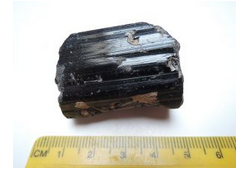6.4.9: Ring Silicates and Paired Tetrahedral Silicates
- Page ID
- 18939
| Ring Silicates and Paired Tetrahedral Silicates | |
| The most common ring silicates | |
| beryl tourmaline cordierite |
Be3Al2Si6O18 (Na,Ca)(Fe,Mg,Al,Li)3Al6(BO3)3Si6O18(OH)4 (Mg,Fe)2Al3(Si5AlO18) |
| The most common paired tetrahedral silicates | |
| epidote zoisite lawsonite |
Ca2(Al2,Fe)(SiO4)(Si2O7)O(OH) Ca2Al3(SiO4)(Si2O7)O(OH) CaAl2Si2O7 |
Ring silicates, generally containing rings of six silicon tetrahedra (see Figure 6.24), are relatively rare. Beryl, tourmaline and cordierite are the only common examples. A few obscure and uncommon minerals have rings of three tetrahedra.
Beryl, tourmaline, and cordierite are sometimes beautiful gemstones. But, the more common varieties are often rather drab. Figures 6.89 and 6.90 show examples of common beryl and tourmaline. Because these mineral have atoms arranged in hexagonal rings, their crystals often exhibit hexagonal symmetry, as can be seen in Figure 6.89. Figure 6.108, later in this chapter, shows an example of gemmy tourmaline. It is similar to one we saw in Figure 4.13 (Chapter 4). Figures 4.1 and 4.30 (Chapter 4) show examples of aquamarine and emerald, both gemmy varieties of beryl.


Paired tetrahedral silicates contain linked pairs of silicon tetrahedra that create an Si2O7 group (see Figure 6.24 earlier in this chapter). Epidote, zoisite, and lawsonite are the most common examples. But, epidote and zoisite contain paired tetrahedra and tetrahedra in other configurations as well. The photos, in Figures 6.91, 6.92, and 6.93 show beautiful examples of these minerals. More common specimens are not so pretty.



Beryl and tourmaline contain beryllium and boron, respectively – these elements are generally quite rare. But, they concentrate in some pegmatites, and that is where most beryl and tourmaline are found. Cordierite and zoisite are both common metamorphic minerals. Lawsonite is a rare high pressure metamorphic mineral associated with metamorphism in subduction zones. The chemistry of tourmaline is highly variable, but the other minerals are generally close to the end member compositions listed in the blue box above.


